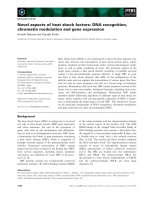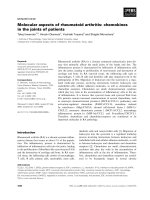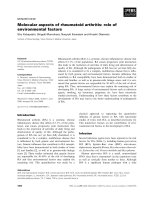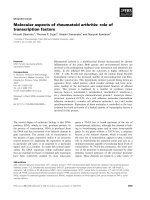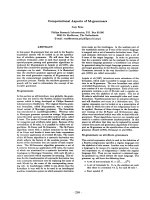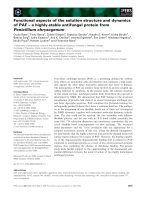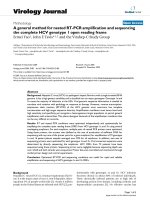Báo cáo sinh học: "Several aspects of Journal of Biology seem to have caught readers’ attention since issue 1 appeared this summer" potx
Bạn đang xem bản rút gọn của tài liệu. Xem và tải ngay bản đầy đủ của tài liệu tại đây (36.79 KB, 1 trang )
Several aspects of Journal of Biology seem
to have caught readers’ attention since
issue 1 appeared this summer. Some of
the questions asked have arisen suffi-
ciently often to be worth addressing
here. In summary, the journal differs
from other top-tier journals in four
main ways. First, and most impor-
tantly, no fee will ever be charged to
readers of the research articles, and
the authors retain full copyright, so
that the articles can be freely read and
distributed by anyone, from the day
of publication onwards, in per-
petuity. This is the ‘open access’
policy of all of the journals published
by BioMed Central, which is currently
the only publisher that is wholly
committed to the principles of open-
access publishing.
Why is the immediate free use and
distribution of the entire article so
important? Not only is it possible and
desirable, but it benefits both scientists
and science; restrictions on use and dis-
tribution serve publishers, not scientists
or readers. Open access also allows full
archiving and retrieval. Extensive efforts
are being made to create public archives
of the scientific literature, containing
complete copies of all scientific papers.
(PubMed Central is one example of
this, and all research articles published
in all BioMed Central journals are
deposited there in full.) In time, these
freely accessible archives will greatly
facilitate the practice and dissemination
of science, and will lead to exciting and
sophisticated ways of using full-text
information, much as GenBank has
done for DNA sequences. The current
restrictions on access, use, and distribu-
tion put in place by most journals -
even those that offer copyright to
authors while in fact denying them per-
mission to distribute their article - will
seriously impede the development and
comprehensiveness of central archives.
Journal of Biology differs in a second
way from some of the best-known
high-profile journals with which it
aims to compete. Its reviewing process
is designed to be as fast, fair, and con-
structive as possible. Decisions are
made jointly by a scientist as editor-in-
chief and a professional editor. No
submitted article is rejected without
advice from a relevant scientist, and
fashion is not a consideration. And at
least one of three peer-reviewers for
each article is chosen from a list
supplied by the authors.
The third difference comes from
our commitment to maximize the
impact of the research we publish.
Each research article is accompanied
by commissioned commentaries. We
aim for the most effective presentation
of data, both online and in print, and
the print issue is distributed free of
charge to over 80,000 life scientists.
Finally, we do not wait for a thresh-
old number of papers of sufficient
quality before publishing an issue.
Instead, an issue appears whenever a
research article of suitable caliber is
ready for publication. For this reason,
the first two issues of Journal of Biology
each contain only one keynote research
article and its associated commentaries.
To date, Journal of Biology has
declined tens of articles for every one it
has published. This is because we are
committed to publishing only the
most significant research. The chal-
lenge is to convince scientists with an
important story to tell to try Journal of
Biology instead of their usual preferred
journal. We have met enthusiasm for
open-access publishing, and for Journal
of Biology, across the board, from stu-
dents to Nobel laureates, and at all
levels in between. The merits of open
access, the wide dissemination of each
article, and the usefulness of the asso-
ciated commentaries, result in each
paper published in Journal of Biology
having unparalleled impact. Why not
make 2003 the year you discover the
benefits of publishing in Journal of
Biology for yourself?
Martin Raff, Editor-in-Chief, Journal of Biology
Theodora Bloom, Editor, Journal of Biology
Peter Newmark, Editorial Director, BioMed
Central
E-mail:
BioMed Central
Journal
of Biology
Editorial
Published: 8 November 2002
Journal of Biology 2002, 1:6
The electronic version of this article is the
complete one and can be found online at
/>© 2002 BioMed Central Ltd ISSN 1475-4924
Journal of Biology 2002, 1:6
Editor’s note
Martin Raff has recently joined the
Scientific Advisory Board of Curis, the
company responsible for the research
article in this issue. He was not involved
in the refereeing of this article or in the
decision to publish it.
